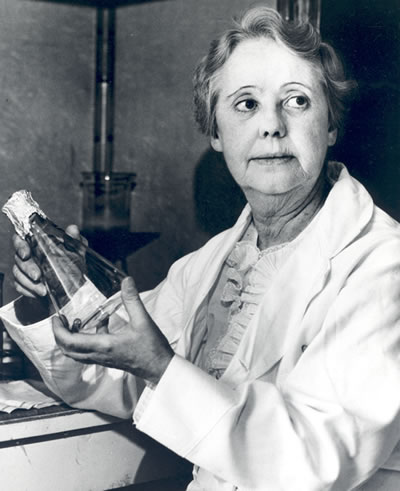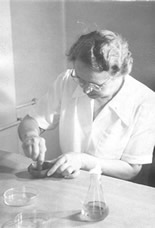 |
| “Smith excelled in small group or one-on-one teaching opportunities.” |
Margaret Gladys Smith was born February 10, 1896, in Carnegie, Pennsylvania. She earned a bachelor’s degree from Mount Holyoke College in 1918 and a medical degree from the Johns Hopkins University in 1922.
Smith’s area of research was pediatric pathology. She focused on viral diseases, including encephalitis, herpes and cytomegaloviruses. Smith was the first to identify St. Louis encephalitis and the first to propagate human herpes virus as well as human cytomegalovirus.
Smith began her academic career as an instructor in pathology at the Johns Hopkins University in 1922. In 1923, she became a research associate and in 1926, assistant professor. She then joined Washington University School of Medicine, holding the positions of assistant professor (1929-43), associate professor (1943-57) and professor (1957-64). She retired in 1964 and became professor emerita.
 |
Margaret Gladys Smith was an early graduate of the Johns Hopkins University Medical School, one of the few schools available to women at the time. Her interest in pathology was heightened by the raging influenza epidemics of the day. She described returning from Christmas vacation and seeing stacks of pine boxes piled outside the Hopkins morgue in 1918. After receiving her medical degree, she stayed on in the Department of Pathology.
Smith was an early recipient of enlightened mentoring. When she applied for a job at Washington University School of Medicine, her chairman at Johns Hopkins cautioned her “not to let them get you for nothing.” When Smith accepted a faculty position for less than her Hopkins appointment, her chairman insisted that she ask for moving expenses.
| “She was, in spite of her innate refinement, not a shrinking violet, but a person of very high standards and strong opinions that she would express forcefully if necessary.” |
| … John M. Kissane Perspectives in Pediatric Pathology 1982 |
Smith’s technical skill and insightfulness led to the discovery and means of propagation of important viruses, such as the St. Louis encephalitis virus and human cytomegalovirus. These discoveries influenced a new generation of pathologists, who used these techniques to advance the field at other universities. Although a shy public speaker, Smith excelled in small group or on-on-one teaching opportunities where her knowledge and experience in pathology were legendary.
Smith was always supportive of female medical students here. In recognition of her dedication to women in medicine and in honor of her own outstanding achievements and excellence, her students, colleagues and alumni established the Margaret Smith Award, which is given to an exemplary female sophomore medical student each year.
